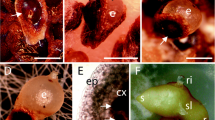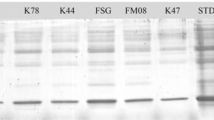Abstract
The potential protection of Picea glehnii seedlings from damping-off by seed-epiphytic Penicillium species was investigated. We studied the chemical response of seed-epiphytic Penicillium species (Pen. cyaneum, Pen. damascenum, and Pen. implicatum) to Pythium vexans, a damping-off fungus, in vitro. Penicillium species were cultured singly or cocultured with Pyt. vexans for 14 or 18 d, and mycelial growth, pH of culture filtrate, antifungal activity of the culture filtrate against Pyt. vexans, and the amount of antifungal compound produced by each Penicillium species, were examined. The filtrate of both the single culture of Penicillium and the coculture of Penicillium and Pyt. vexans showed antifungal activity against Pyt. vexans. In a coculture with Pyt. vexans, Pen. cyaneum produced an antifungal compound (patulin) as in the single culture. Pen. damascenum cocultured with Pyt. vexans produced an antifungal compound (citrinin), as it did in the single culture and in larger amounts on day 10. Pen. implicatum produced two antifungal compounds, frequentin and palitantin, and the ratio of frequentin (with higher antifungal activity than palitantin) to palitantin was higher in the coculture with Pyt. vexans than in the single culture. Our results indicate that these Penicillium species have the ability to produce antifungal compounds and to keep antifungal activity under competitive condition with Pyt. vexans. The chemical response of these Penicillium species to Pyt. vexans may contribute to protect P. glehnii seedlings from damage by Pyt. vexans.






Similar content being viewed by others
References
C. H. Dickinson J. A. Lucas (1982) Plant Pathology and Plant Pathogens Blackwell Scientific Publications Oxford
K. Endo A. Kishida M. Shinta (1985) ArticleTitleDamages by microorganism participated in natural regeneration Trans. Meet. Hokkaido Br. Jpn. For. Soc. 34 104–105
S. J. Grayston D. Vaughan D. Jones (1996) ArticleTitleRhizosphere carbon flow in trees, in comparison with annual plants: The importance of root exudation and its impact on microbial activity and nutrient availability Appl. Soil Ecol. 5 29–56 Occurrence Handle10.1016/S0929-1393(96)00126-6
Kasuya, M. C. M. 1995. Ecological and physiological studies on ectomycorrhizae of Picea glehnii (Fr. Schm.) Masters. Ph.D. Dissertation. University of Hokkaido, Sapporo.
A. E. Mackie R. E. Wheatley (1999) ArticleTitleEffects and incidence of volatile organic compound interactions between soil bacterial and fungal isolates Soil Biol. Biochem. 31 375–385 Occurrence Handle10.1016/S0038-0717(98)00140-0 Occurrence Handle1:CAS:528:DyaK1MXitVOrsb0%3D
K. Matsuda (1989) ArticleTitleRegeneration and growth in the Picea glehnii forest Res. Bull. Coll. Exp. For. Fac. Agric. Hokkaido Univ. 46 595–717
D. D. Perrin B. Dempsey (1974) Buffers for pH and Metal Ion Control Chapman and Hall London
M. J. Perry J. F. Markins M. W. Adlard G. Holt (1984) ArticleTitleAspergillic acids produced by mixed culture of Aspergillus flavus and Aspergillus nidulans J. Gen. Microbiol. 130 319–323 Occurrence Handle1:CAS:528:DyaL2cXktVGmsr8%3D Occurrence Handle6427396
E. A. Peterson (1959) ArticleTitleSeed-borne fungi in relation to colonization of roots Can. J. Microbiol. 5 579–582 Occurrence Handle1:STN:280:CC%2BC1cvpsFw%3D Occurrence Handle14432240
R. D. Phillips H. A. Wallace W. O. Bemdt (1980) ArticleTitleHigh-performance liquid chromatographic analysis of the mycotoxin citrinin and its application to biological fluids J. Chromatogr. 190 419–427 Occurrence Handle1:CAS:528:DyaL3cXkt1Snsrs%3D Occurrence Handle7380957
I. Takahashi (1980) ArticleTitleThe research for fungi which appeared during natural regeneration of Picea jezoensis and Abies sachalinensis Trans. Meet. Hokkaido Br. Jpn. For. Soc. 29 125–127
M. Tatewaki (1958) ArticleTitleForest ecology of the islands of the North Pacific Ocean J. Fac. Agric., Hokkaido Univ. 50 371–486
K. Tokimoto T. Fujita Y. Takeda Y. Takahashi (1987) ArticleTitleIncreased or induced formation of antifungal substances in cultures of Lentinus edodes by the attack of Trichoderma spp Proc. Jpn. Acad. 63 277–280 Occurrence Handle1:CAS:528:DyaL1cXhs1CqsL0%3D
T. Watanabe (2002) Pictorial Atlas of Soil and Seed Fungi CRC Press Boca Raton
K. Yamaji Y. Fukushi Y. Hashidoko T. Yoshida S. Tahara (1999) ArticleTitleCharacterization of antifungal metabolites produced by Penicillium species isolated from seeds of Picea glehnii J. Chem. Ecol. 25 1643–1654 Occurrence Handle1:CAS:528:DyaK1MXkvVKksb0%3D
K. Yamaji Y. Fukushi Y. Hashidoko S. Tahara (2001) ArticleTitlePenicillium fungi from Picea glehnii seeds protect the seedlings from damping-off New Phytol. 152 521–531 Occurrence Handle1:CAS:528:DC%2BD38XisFWqsA%3D%3D
Acknowledgments
We thank Dr. Kasuya, M.C.M., Vicosa Federal University for supplying Pythium vexans.
Author information
Authors and Affiliations
Corresponding author
Rights and permissions
About this article
Cite this article
Yamaji, K., Hashidoko, Y., Fukushi, Y. et al. Chemical Response of Picea glehnii Seed-Epiphytic Penicillium Species to Pythium vexans under In Vitro Competitive Conditions for Mycelial Growth. J Chem Ecol 31, 805–817 (2005). https://doi.org/10.1007/s10886-005-3545-9
Received:
Revised:
Accepted:
Published:
Issue Date:
DOI: https://doi.org/10.1007/s10886-005-3545-9




